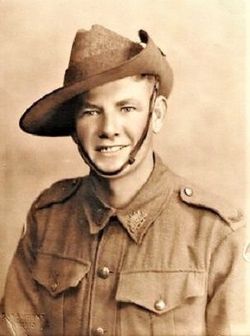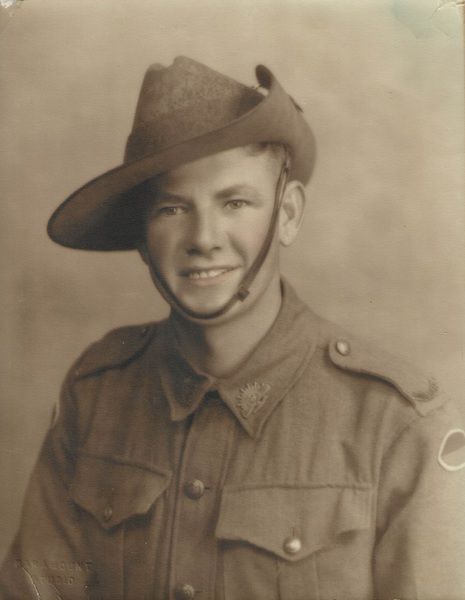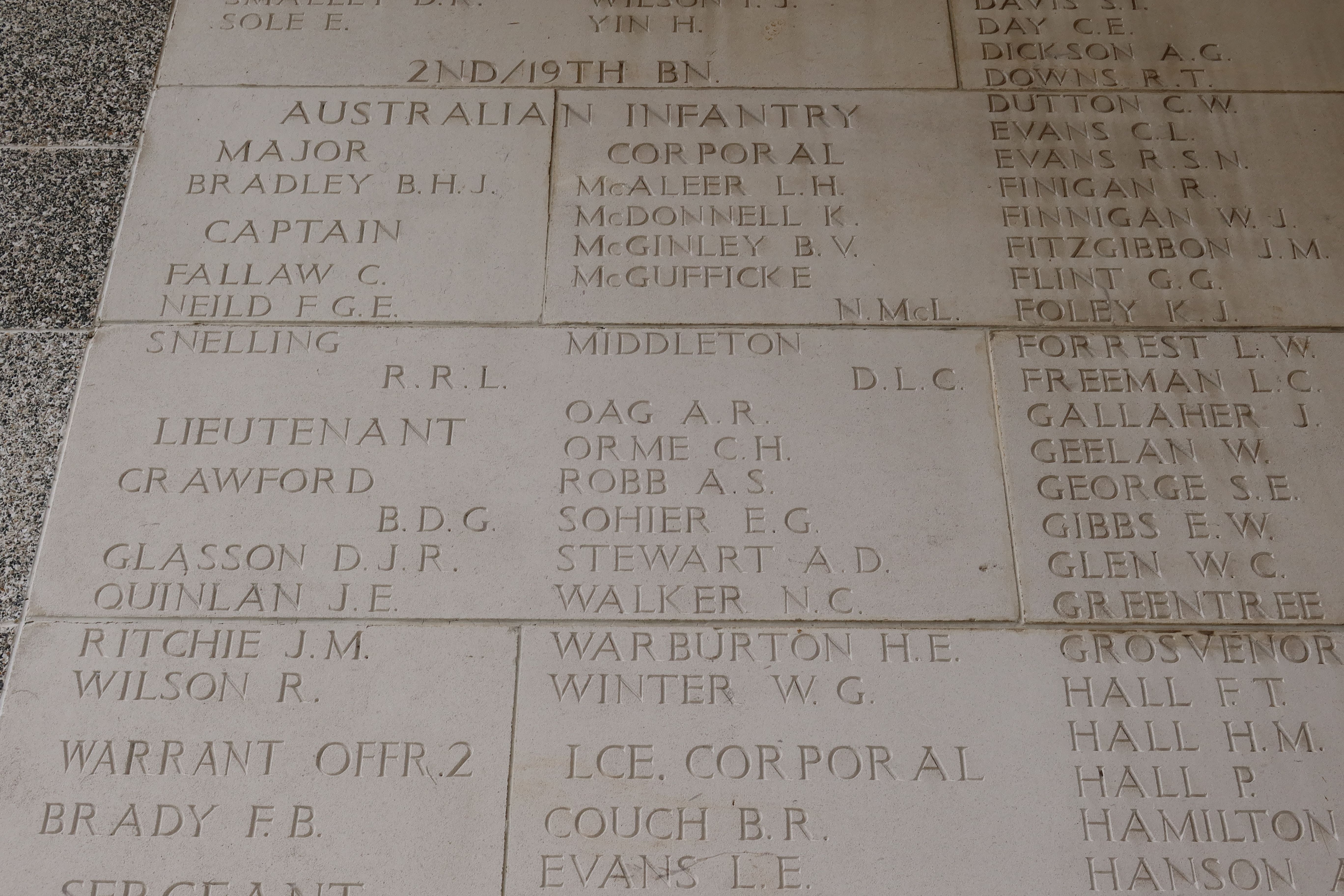Enlisted:--- 2ndJuly 1940,
Final Rank:--- Private
Final Unit:--- 2nd/19th Australian Infantry Battalion, 2nd AIF.
Born:--- Woollahra, New South Wales, Australia, 1st April 1913
Home Town:--- Bathurst, Bathurst Regional, New South Wales
Schooling:--- St Francis' School, Paddington & St Patricks, Bathurst
Civilian employment: ---Cannery Hand
Fate:--- Presumed, to have died in Malaya, 22 January 1942, aged 28 years. Private Clarence Evans was murdered at the hands of the Japanese, in the Massacre at Parit Sulong, where wounded Australian/ Allied soldiers were killed, incinderated and systematically run over, back and forwards, by Japanese driven trucks under the command of Japanese Imperial Forces as ordered by Lieutenant General Takuma Nishimura.
Burial:--- No known grave. "Known unto God".
Parents:--- John Green
Memorials:--- Australian War Memorial Roll of Honour, Singapore Memorial Kranji War Cemetery
~~~~~~~~~~~~~~Biography contributed by Jennifer Olive~~~~~~~~~~~~~~~~~~
Clarence (Clarrie) Leslie Evans was born in Woollahra, Sydney on 1 April 1913 the second son of John (Les) and Vera. His father was a hairdresser in Oxford Street, Paddington when Clarrie was born. He attended St Francis' School Paddington with his brothers & sisters. After the family moved to Bathurst in 1926, he and his brothers attended St Patrick's. Clarrie worked at Edgell's factory and was a great sportsman excelling at cricket, rugby league and hockey. Private Evans, prior to his enlistment was one of the most prominent on the sporting fields of Bathurst. He was one of the best batsmen in the well-known King Parade club as well as one of the most prominent players in the all-conquering Charleston's League Football Club. He also played hockey with the Waratahs II team.
He enlisted in the Australia Army on 2 July 1940 and became Private Clarence Leslie Evans NX55861 2/19th Australian Infantry Battalion. He was one of the first Australian soldiers to land in Malaya during WWII. Clarrie was reported wounded and missing in Malaya on 22 January 1942 and presumed dead at the end of the war.
The last word concerning the deceased was given to his father by Private Wright, of Bathurst, who stated that he was with young Evans when he was wounded in the stomach and that at the time the party was surrounded by Japanese. If the deceased had not been fatally wounded, then he would have been a prisoner of war. Extensive enquiries were made by the family regarding his fate however it was approximately three years later that a notice was received declaring that Clarrie was missing presumed dead. The following information has been extracted from an account of the Massacre at Parit Sulong in Malaya where it is known that Private Clarence Evans was killed at the hands of the Japanese. Lynette Silver has kindly given permission for this extract to be included in the tribute to Clarrie Evans. Further information can be obtained from https://lynettesilver.com/investigations/parit-sulong-west-malaysia/
In January 1942, as the Japanese pushed the main Allied army down the Malay peninsula, two under-strength Australian infantry battalions, a handful of gunners and a depleted Indian Army contingent had held back a vastly superior enemy force of 10,000 crack Japanese Imperial Guards. This epic battle, which prevented the enemy from cutting off the line of retreat of the main Allied forces, was one of the most desperate, and least known, fighting retreats of the Second World War, for which the Australian commander Lieutenant-Charles Anderson was awarded a Victoria Cross.
After four days of relentless combat, the defenders had reached the bridge at the village of Parit Sulong, only to find it in Japanese hands. Unable to break through and with no hope of relief, surrounded by superior enemy forces but unwilling to surrender, Anderson gave the order 'every man for himself'. Left behind at the bridge were the very badly wounded – over 100 Australian and 35 Indian soldiers, expecting Red Cross protection. This was not to be, and what followed was one of the most infamous massacres of World War 2.
It was not until mid-afternoon on 22 January, following the withdrawal of the able-bodied, that the enemy reached the convoy. Shouting and yelling, they forced the wounded from the vehicles and across a parit (drainage ditch) to the front of a Public Works Department (PWD) accommodation block. Anyone who lagged behind was belted with rifle butts, kicked, bayoneted, or shot.
After being stripped and searched, the captives were crammed at bayonet point into a small garage. The Japanese paid no heed to screams of the badly wounded, and several died of suffocation before the group was moved to two rooms at the end of the main block.
Just before sunset, each prisoner's hands were tied with a length of rope or signal wire, which was then passed around his neck and secured to the next prisoner. Anyone who could not stay upright was cut from the line, bashed or bayoneted, and left for dead.
They were then forcibly moved in groups around the far end of the building and machine-gunned. Bodies of those who had been cut from the line, or died previously, were added to the pile of the dead and dying. Dousing them with petrol, the Japanese then set them alight, in a futile attempt to destroy the evidence of their crime.
Post-war, not a single trace of any of these victims was found. As the Japanese claimed that they had been cremated, no further investigation to locate the remains was ever undertaken.
Although all physical evidence of the massacre had 'vanished', the Japanese responsible did not escape retribution. Lieutenant Ben Hackney, although badly wounded and suffering from a broken leg, had been cut from the line. Left for dead, he lay hidden in the shadows throughout the massacre, before he managed to drag himself to a safe hiding place. Although recaptured five weeks later, he survived the war and became the prosecution's prime witness. General Nishimura, who had ordered the execution of the wounded prisoners, was brought to trial in 1950, and hanged in June the following year.
Private Clarence Leslie Evans was amongst those killed by the Japanese at Parit Sulong.
Lest we Forget.
Enlisted:--- 2ndJuly 1940,
Final Rank:--- Private
Final Unit:--- 2nd/19th Australian Infantry Battalion, 2nd AIF.
Born:--- Woollahra, New South Wales, Australia, 1st April 1913
Home Town:--- Bathurst, Bathurst Regional, New South Wales
Schooling:--- St Francis' School, Paddington & St Patricks, Bathurst
Civilian employment: ---Cannery Hand
Fate:--- Presumed, to have died in Malaya, 22 January 1942, aged 28 years. Private Clarence Evans was murdered at the hands of the Japanese, in the Massacre at Parit Sulong, where wounded Australian/ Allied soldiers were killed, incinderated and systematically run over, back and forwards, by Japanese driven trucks under the command of Japanese Imperial Forces as ordered by Lieutenant General Takuma Nishimura.
Burial:--- No known grave. "Known unto God".
Parents:--- John Green
Memorials:--- Australian War Memorial Roll of Honour, Singapore Memorial Kranji War Cemetery
~~~~~~~~~~~~~~Biography contributed by Jennifer Olive~~~~~~~~~~~~~~~~~~
Clarence (Clarrie) Leslie Evans was born in Woollahra, Sydney on 1 April 1913 the second son of John (Les) and Vera. His father was a hairdresser in Oxford Street, Paddington when Clarrie was born. He attended St Francis' School Paddington with his brothers & sisters. After the family moved to Bathurst in 1926, he and his brothers attended St Patrick's. Clarrie worked at Edgell's factory and was a great sportsman excelling at cricket, rugby league and hockey. Private Evans, prior to his enlistment was one of the most prominent on the sporting fields of Bathurst. He was one of the best batsmen in the well-known King Parade club as well as one of the most prominent players in the all-conquering Charleston's League Football Club. He also played hockey with the Waratahs II team.
He enlisted in the Australia Army on 2 July 1940 and became Private Clarence Leslie Evans NX55861 2/19th Australian Infantry Battalion. He was one of the first Australian soldiers to land in Malaya during WWII. Clarrie was reported wounded and missing in Malaya on 22 January 1942 and presumed dead at the end of the war.
The last word concerning the deceased was given to his father by Private Wright, of Bathurst, who stated that he was with young Evans when he was wounded in the stomach and that at the time the party was surrounded by Japanese. If the deceased had not been fatally wounded, then he would have been a prisoner of war. Extensive enquiries were made by the family regarding his fate however it was approximately three years later that a notice was received declaring that Clarrie was missing presumed dead. The following information has been extracted from an account of the Massacre at Parit Sulong in Malaya where it is known that Private Clarence Evans was killed at the hands of the Japanese. Lynette Silver has kindly given permission for this extract to be included in the tribute to Clarrie Evans. Further information can be obtained from https://lynettesilver.com/investigations/parit-sulong-west-malaysia/
In January 1942, as the Japanese pushed the main Allied army down the Malay peninsula, two under-strength Australian infantry battalions, a handful of gunners and a depleted Indian Army contingent had held back a vastly superior enemy force of 10,000 crack Japanese Imperial Guards. This epic battle, which prevented the enemy from cutting off the line of retreat of the main Allied forces, was one of the most desperate, and least known, fighting retreats of the Second World War, for which the Australian commander Lieutenant-Charles Anderson was awarded a Victoria Cross.
After four days of relentless combat, the defenders had reached the bridge at the village of Parit Sulong, only to find it in Japanese hands. Unable to break through and with no hope of relief, surrounded by superior enemy forces but unwilling to surrender, Anderson gave the order 'every man for himself'. Left behind at the bridge were the very badly wounded – over 100 Australian and 35 Indian soldiers, expecting Red Cross protection. This was not to be, and what followed was one of the most infamous massacres of World War 2.
It was not until mid-afternoon on 22 January, following the withdrawal of the able-bodied, that the enemy reached the convoy. Shouting and yelling, they forced the wounded from the vehicles and across a parit (drainage ditch) to the front of a Public Works Department (PWD) accommodation block. Anyone who lagged behind was belted with rifle butts, kicked, bayoneted, or shot.
After being stripped and searched, the captives were crammed at bayonet point into a small garage. The Japanese paid no heed to screams of the badly wounded, and several died of suffocation before the group was moved to two rooms at the end of the main block.
Just before sunset, each prisoner's hands were tied with a length of rope or signal wire, which was then passed around his neck and secured to the next prisoner. Anyone who could not stay upright was cut from the line, bashed or bayoneted, and left for dead.
They were then forcibly moved in groups around the far end of the building and machine-gunned. Bodies of those who had been cut from the line, or died previously, were added to the pile of the dead and dying. Dousing them with petrol, the Japanese then set them alight, in a futile attempt to destroy the evidence of their crime.
Post-war, not a single trace of any of these victims was found. As the Japanese claimed that they had been cremated, no further investigation to locate the remains was ever undertaken.
Although all physical evidence of the massacre had 'vanished', the Japanese responsible did not escape retribution. Lieutenant Ben Hackney, although badly wounded and suffering from a broken leg, had been cut from the line. Left for dead, he lay hidden in the shadows throughout the massacre, before he managed to drag himself to a safe hiding place. Although recaptured five weeks later, he survived the war and became the prosecution's prime witness. General Nishimura, who had ordered the execution of the wounded prisoners, was brought to trial in 1950, and hanged in June the following year.
Private Clarence Leslie Evans was amongst those killed by the Japanese at Parit Sulong.
Lest we Forget.
Gravesite Details
Private, Australian Infantry. Age: 28.
Sponsored by Ancestry
Advertisement
Records on Ancestry
Sponsored by Ancestry
Advertisement




